Luxury-appointed CapeCod Class B from a new Elkhart, Indiana-based manufacturer makes a big splash
Class B motorhomes have become increasingly popular among newer enthusiasts looking for a nimble, go-anywhere touring vehicle with all the amenities and features for on-the-road comfort, and for seasoned owners looking to downsize to a smaller, easier-to-maneuver motorhome. Class B’s are also popular as second household vehicles, and are sometimes used primarily for touring.
Brand-new manufacturer, Grand Coach, of Elkhart, Indiana, has begun production with a line of Class B motorhomes that Darryl Connors, founder and CEO, says brings the concept of quality control and design to a higher level. To prove it, they sent MotorHome coach No. 001, a 2017 Grand Coach CapeCod, to test. Sending your very first prototype to a magazine for a test and review is bold no matter how you slice it. But Connors, whose infant company bought the rights to some well-established brands in the RV world like CapeCod, Dolphin, Honey, Sea View, Tropical Breeze and Marlin, was confident of the outcome.
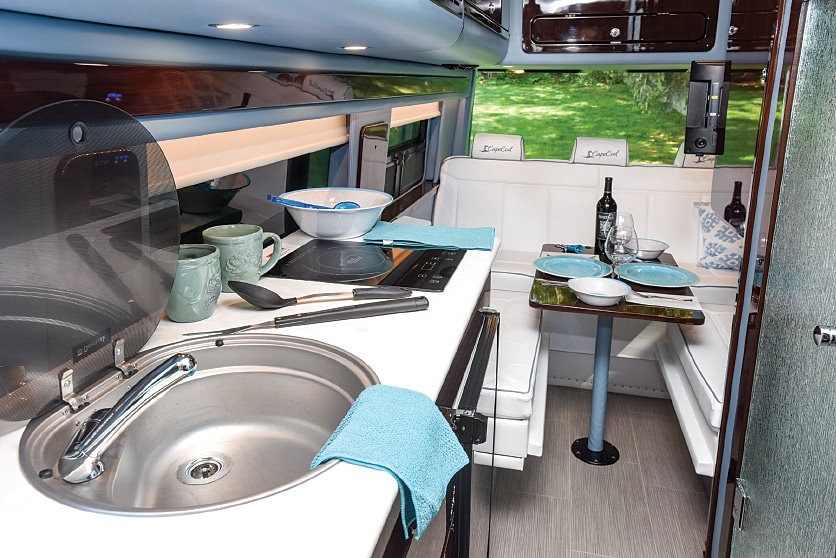
The galley is compact but well- equipped, with a single-basin sink, induction cooktop, microwave and refrigerator/freezer.
Looking at the names the company has acquired, the ocean resort theme isn’t hard to miss and is intentional, according to Connors. The CapeCod, with its sophisticated New England seaside theme, is identical to the Dolphin in every way, except the colors and décor theme. The Dolphin is more Southeast and West Coast-themed – a Margaritaville on wheels, if you will. A future model in development, called the Aztec, will have a Western theme.
On viewing the CapeCod for the first time it’s clear this is no ordinary motorhome. There are times when you can judge a vehicle, and indeed a motorhome, by its cover, which in this case is the paint and exterior trim that stops people in their tracks. During the test and photoshoot we were approached at least five times by people asking questions and asking to take pictures.
The exterior of the motorhome has a custom paint job that fades from silver at the top to a lagoon blue at the bottom, and is quite well-done. Speaking of the bottom, the motorhome is surrounded by fiberglass, ground-effect running boards and a custom spoiler on the front that gives it a low-to-the-ground, sleek appearance. Alcoa cast-aluminum wheels with Mercedes-Benz logos in the center are a sharp touch.
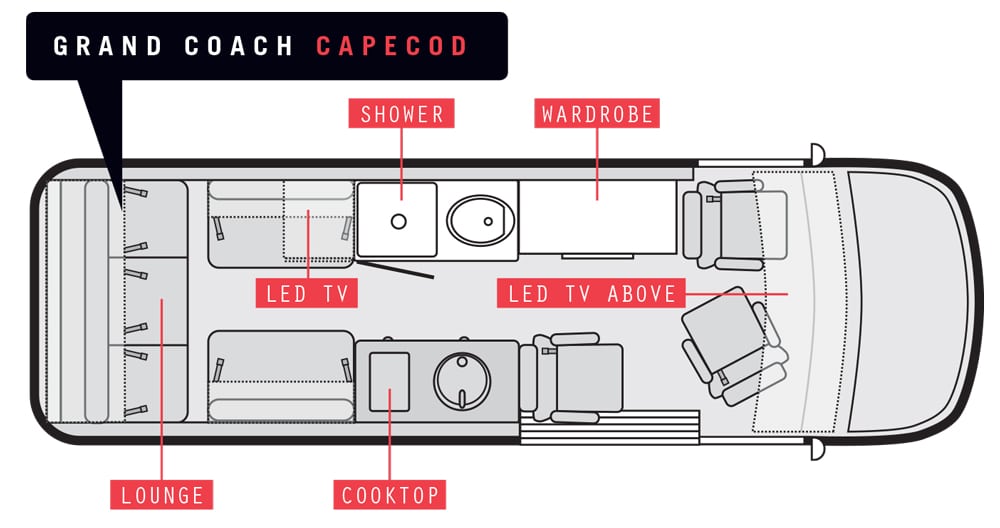
The paint and color theme transition to the inside where, again, no detail has been left undone. The cockpit of the CapeCod is a thing of beauty and comfort. Most of the surfaces are clad in ultraleather, a soft, supple vinyl fabric that is well-known for its comfort and durability.
The dashboard and side door panels were removed and painted to match the theme colors. Custom-embroidered ultraleather panels with the CapeCod logo were integrated into the doors; the front rotating Mercedes-Benz multiposition seats were reupholstered in the same fabric and theme with the logo again embroidered into the headrests. The dash has a Mercedes-Benz-like wood trim, and eight cup holders for the folks who like to have coffee and pop at the ready all the time they’re driving. The top of the dash is divided into three open storage cubbies with cup holders and above the sun visors are two more storage spaces, plus huge pockets in the doors, which all adds up to a ton of storage.
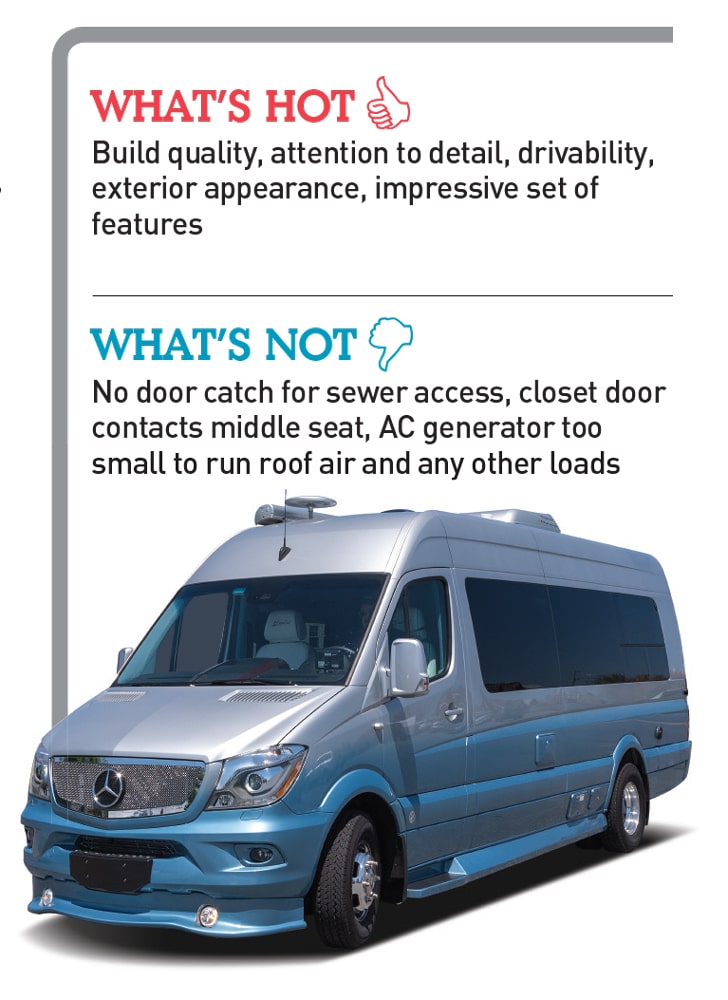 The cockpit is well-laid-out and everything is within easy reach. The smart steering wheel is comfortable to grip with stereo controls on the front, and various control stalks for the cruise control, wipers and turn signals. The big chrome Mercedes-Benz badge in the center of the steering wheel is a not-so-subtle reminder that you’re driving a $150,000 vehicle.
The cockpit is well-laid-out and everything is within easy reach. The smart steering wheel is comfortable to grip with stereo controls on the front, and various control stalks for the cruise control, wipers and turn signals. The big chrome Mercedes-Benz badge in the center of the steering wheel is a not-so-subtle reminder that you’re driving a $150,000 vehicle.
There are a lot of switches on the dash, some of which are part of the American Technology Components multiplex switching system found throughout the interior. This motorhome has six control panels that are programmed to operate many of the functions, including all the interior and exterior LED lighting, front fog lights, power for the integrated entertainment components, Carefree power box awning with LED lighting and more. One of the panels is on the dashboard to the left of the steering column, giving the driver convenient control of some of these functions.
The dashboard center pod contains the Mercedes-Benz HVAC controls for the dash air and heat, which allow for a high degree of adjustability. The Fusion RV-IN801 A Class infotainment stereo system, installed at the top of the pod, is a multifeature stereo that any electronics geek will want to play with. The stereo features USB, HDMI and audio inputs either on the front of the stereo unit, or via an access point built onto the top of the dash on the driver’s-side dashboard. Features include DVD/CD playback, Bluetooth connectivity, AM/FM stereo, Sirius/XM satellite radio, Wi-Fi connectivity with an internet browser with various apps and, most notably, an integrated Garmin RV GPS program. This system has great functionality, with full campground and RV services listings, and the Android-powered internet browser will allow users to look up anything on the net, including weather forecasts and tourism sites. We connected our iPhone 6 to the system, and the stereo sound was quite good, vigorously belting out Beach Boys tunes. The steering-wheel controls are mated with the stereo, and the multicolor LED touch panel is within easy reach, although somewhat difficult to see during a sunny day due to glare and reflections.
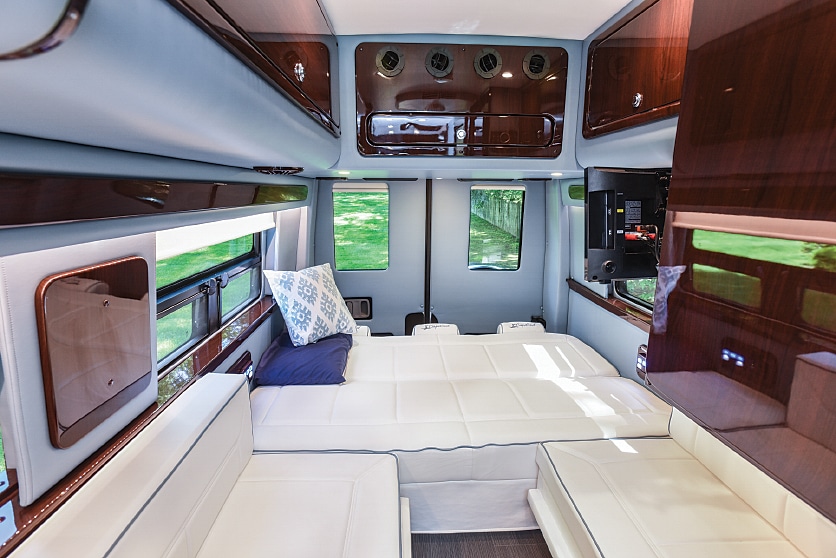
With the bed folded down there is plenty of room for two people with dual twin beds. Add the center section and cushions to make a queen bed.
We enjoyed the CapeCod’s driving and handling, and seized the opportunity to tour the famous region after which the motorhome has been named. The motorhome is built on a Mercedes-Benz 3500, 170-inch wheelbase, dual rear-wheel van, featuring the BlueTEC 3.0-liter V-6 turbodiesel, which delivers 188 hp and 325 lb-ft of torque through its five-speed automatic transmission with manual-shift capability. Acceleration, even going up hills, was decent. While there was some sway, especially at low speeds – which is to be expected of a heavy, high-profile van – it was minimal, and otherwise the handling was tight and responsive. One of the benefits is fuel economy and while many motorhomes will only see 5-7 mpg, we recorded 15.5 mpg on the highway, which is pretty respectable.
The CapeCod as built on the Mercedes-Benz platform comes with safety features not often seen in motorhomes. First, there’s a four-camera safety system with two primary monitors, and the backup camera also displays on the Fusion stereo screen. There are forward-facing, backup and side cameras, all visible through the dual monitor system: one on the top of the dashboard on the driver’s side, and one in the rear mounted below the TV. There are driver and passenger side curtain, steering wheel and dashboard air bags, which provide nearly full-coverage protection in the event of a collision. However, the likelihood of a collision has been greatly reduced, thanks to the lane keeping, the collision prevention and the blind spot assist features. The lane keeping assist system automatically detects the striping on the road and gives visual and audible warnings if the driver strays out of his or her lane. The collision prevention assist is a radar-based proximity warning system that gives similar warnings if the vehicle ahead is too close, and in the event of an emergency, provides boosted braking to avoid a rear-end collision. Lastly, the blind spot assist uses radar on the sides to monitor approaching vehicles hidden in a blind spot. Colored LEDs in the mirrors indicate if the coast is clear, and if you use the turn signal when a vehicle is in the blind spot, an alarm also goes off, in addition to an LED for a visual alert.
 From a livability standpoint, many of the features you’d expect in a high-end coach can be found in the CapeCod in a compact form. The interior is nicely appointed. Seating is clad in the aforementioned ultraleather, and is quite comfortable. This includes a captain’s chair by the side door, and an electrically folding jackknife sofa bed across the rear. Two smaller seats, one on each side, sit immediately in front of the sofa, and while less than ideal for sitting, add to the bed surface when the separate bed-board is positioned and the back cushions are tucked into the center. A tabletop, stored in one of the two closets, locks into a special post that attaches to the floor. This post allows the table to turn freely to make it easier for people to navigate the table while trying to sit. The table is secure and stable but polished so finely that things slide on the surface. Also, it’s a bit of a reach to the table from the couch, and while we could set the table in a more formal style, we’d be comfortable having a more informal setting for convenience.
From a livability standpoint, many of the features you’d expect in a high-end coach can be found in the CapeCod in a compact form. The interior is nicely appointed. Seating is clad in the aforementioned ultraleather, and is quite comfortable. This includes a captain’s chair by the side door, and an electrically folding jackknife sofa bed across the rear. Two smaller seats, one on each side, sit immediately in front of the sofa, and while less than ideal for sitting, add to the bed surface when the separate bed-board is positioned and the back cushions are tucked into the center. A tabletop, stored in one of the two closets, locks into a special post that attaches to the floor. This post allows the table to turn freely to make it easier for people to navigate the table while trying to sit. The table is secure and stable but polished so finely that things slide on the surface. Also, it’s a bit of a reach to the table from the couch, and while we could set the table in a more formal style, we’d be comfortable having a more informal setting for convenience.
Next to the captain’s chair is a closet with drawers, neatly hidden behind two cabinet doors. One of the doors wouldn’t open all the way, as it made contact with the armrest on the chair, but this is easily remedied. Above the captain’s chair toward the front is a 27-inch Samsung smart LED TV built into the headliner and connected to the DVD and Apple TV systems. In addition, a smaller 19-inch flat-screen TV is located in the rear (in front of the sofa) for close-up viewing. The Grand Coach also has a central Cradlepoint cellular-based Wi-Fi router system, which provides Wi-Fi internet connectivity (from a cellular subscription) to the TV, Apple TV, the Fusion Infotainment system and any other internet-ready device, including tablets and phones.
The interior lighting is all LED with ceiling fixtures and accent lighting hidden in the valances. Each cabinet is lit and also lined in ultraleather, and the doors have flush-mounted push-button latches.
The entire floor is covered by a high-end textured vinyl sheet material, in a light gray wood pattern, which makes for easy care. There are removable, color-coordinated floor mats for the cockpit and the aisle floor.
The galley is, as you’d expect, tiny, and simple cooking chores can be handled adequately. It features a solid-surface 20-by-48-inch countertop with a Dometic glass-top sink with fold-down faucet, a single-burner induction cooktop and beneath, a Norcold 3.1-cubic-foot AC/DC refrigerator/freezer. Above are a small cabinet and a High Pointe 0.9-cubic-foot microwave oven. Below, three drawers with flush-mount push-button locks allow for ample storage of cooking utensils.
The wet bath is a bit cramped but well-appointed with a chrome shower, Thetford ceramic toilet and a heavy textured-glass shower door with chrome hinges and latch. A small exhaust fan built into the roof makes ventilation a breeze, though head and shoulder room will be an issue for those standing 6 feet and taller.
Grand Coach has packed in the utility systems to cover every situation. AC power is provided by either the 30-amp shorepower cord or 15-amp shorepower cord adapter (which requires your own extension cord), but is ideal for a quick plug-in at home to charge batteries and keep the fridge cold; a 2-kW inverter; or an Onan LP-gas-powered 2.5-kW genset. DC power is provided by two Kinetik 3,800-watt AGM batteries, mounted under the rear floor, and tied in to the GoPower IC 2000 inverter/charger. The system is also fed by a 160-watt rooftop GoPower solar charging system.
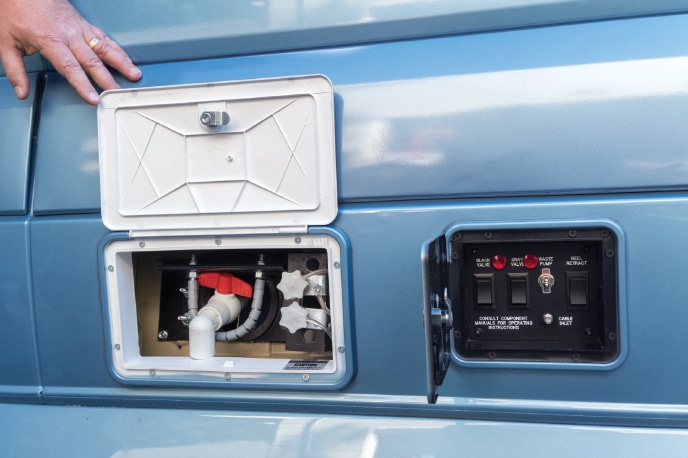
Sewage disposal and tank flushing is easy with the macerator system with electric reel.
The water system is designed for all-season, all-location use. The freshwater, gray- and black-water holding tanks are protected from freezing with Ultra-Heat holding-tank heaters. These heaters are powered by 12-volt DC so, if you’re dry camping, you’ll need to ensure the batteries are conditioned properly. The holding tanks drain through a built-in Thetford Sani-Con macerator system with an electric hose reel and electrically operated holding-tank valves, all controlled from an outside panel. Both holding tanks also have built-in tank flushers to make sure they’re completely clean.
Grand Coach motorhomes have what the company calls SmartCamp Technology, which includes a water system that, according to Connors, will filter the water into bottled-water quality at the tap. This special system includes a fine-particulate filter and an ozone treatment process, and features a special antimicrobial freshwater tank. Additionally, the motorhome can be configured for dry-camping capabilities for up to seven days with the optional lithium-ion generator system.
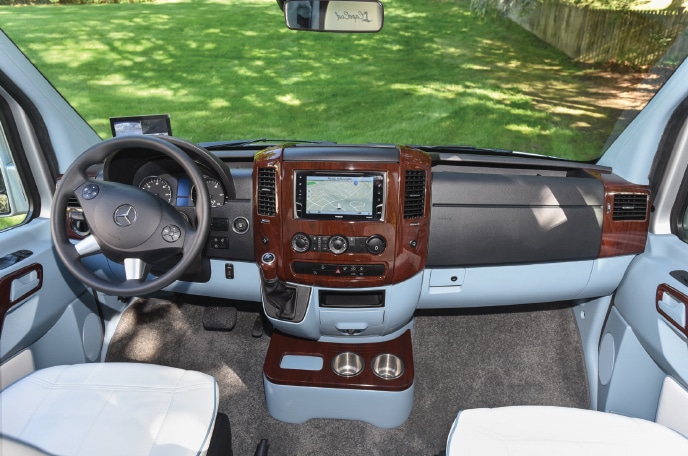
The driver’s compartment is luxurious and comfortable. Note the matching painted panels.
Heat and hot water are provided by a Truma Combi unit, which combines a 2.6-gallon water heater and furnace in one, all controlled by a digital control panel. Further, the rear of the coach is served by a Dometic 13,500-Btu rooftop air conditioner with digital thermostat, as well as a rear, limo-style automotive air-conditioning system to use while on the road for the comfort of rear passengers. The digital control panel for this system is in the rear by the couch, and we’d love to see an additional panel up front so the driver can also have control of the system. Once the engine is turned off, the system shuts down and defaults to off, requiring a trip to the back to turn it on again on a hot day. The Dometic roof air conditioner will run from the standard 2.8-kW Onan LP-gas-powered generator; however, the energy management system cuts off AC power to the rest of the motorhome when the air conditioner is running.
We found the overall quality of the new CapeCod to be excellent, backed up by an extended lifetime, nontransferable powertrain warranty and a five-year, 60,000-mile limited coach warranty. Driving the CapeCod is comfortable and relaxing, with plenty of power to handle most driving conditions, and livability is great, considering its size limitations. It was a perfect fit for a visit to its namesake, and if you’re looking for a Class B touring motorhome of this caliber and price, the Grand Coach CapeCod may be a perfect fit for you.
Grand Coach LLC | 574-264-3951 | www.grand-coach.com


